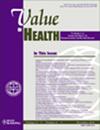The Psychometric Performance of the EQ Health and Wellbeing in Caregivers of Persons Living With Dementia
IF 6
2区 医学
Q1 ECONOMICS
引用次数: 0
Abstract
Objectives
The EQ Health and Wellbeing (EQ-HWB) is a generic instrument recently developed for use in economic evaluations across public health and social care, including impacts on caregivers. Providing informal care to a person living with dementia can significantly affect the health and well-being of carers. However, it is unclear to what extent the EQ-HWB can capture such impacts. We aimed to investigate the psychometric properties of the EQ-HWB compared with other available instruments in caregivers of persons living with dementia.
Methods
An online survey included demographics, informal care-related questions, and quality-of-life measures suitable for caregivers (C-DEMQOL and CarerQol) and the 25-item EQ-HWB. We used the UK pilot value set for the index scores for the EQ-HWB-S (9-item short form). The psychometric properties of the EQ-HWB and EQ-HWB-S were assessed in terms of acceptability (missing data), response distribution, known-groups validity analysis using t tests and one-way ANOVAs (Cohen’s d and Eta squared for effect size), convergent validity (Spearman correlations), and an exploration of dimensionality using exploratory factor analysis.
Results
In known-group validity analysis, the EQ-HWB instruments performed similarly to the C-DEMQOL in terms of effect sizes across a range of variables and slightly better than the CarerQol on some variables. At the item level, 13 of the 25 items could discriminate respondents by caregiving time and 23 of 25 items by caregivers’ general self-reported health. Most hypothesized correlations in the convergent validity analysis were found to be above 0.3.
Conclusions
Our results suggest that the EQ-HWB instruments performed well in this population.
痴呆患者照护者EQ-HWB的心理测量表现。
情商健康与幸福(EQ- hwb)是最近开发的一种通用工具,用于公共卫生和社会保健的经济评估,包括对照顾者的影响。向痴呆症患者提供非正式护理会对护理人员的健康和福祉产生重大影响。然而,目前尚不清楚EQ-HWB能在多大程度上捕捉到这种影响。本项目旨在研究EQ-HWB的心理测量特性,与其他可用的工具相比,痴呆症患者的照顾者。方法:一项在线调查,包括人口统计、非正式护理相关问题、适合照顾者的生活质量测量(C-DEMQOL和CarerQol)和25项EQ-HWB。我们使用英国试点值设置EQ-HWB-S(9项简短形式)的指数得分。EQ-HWB和EQ-HWB- s的心理测量特性通过可接受性(缺失数据)、反应分布、使用t检验和单因素方差分析的已知组效度分析(效应大小为Cohen's d和eta平方)、收敛效度(Spearman相关性)和使用探索性因子分析的维度探索来评估。结果:在已知组效度分析中,EQ-HWB仪器在一系列变量的效应大小方面与C-DEMQOL相似,并且在某些变量上略优于CarerQol。在项目水平上,25个项目中的13个可以通过照顾时间来区分被调查者,25个项目中的23个可以通过照顾者一般自我报告的健康来区分被调查者。在收敛效度分析中,大多数假设相关性都在0.3以上。结论:我们的结果表明EQ-HWB器械在这一人群中表现良好。
本文章由计算机程序翻译,如有差异,请以英文原文为准。
求助全文
约1分钟内获得全文
求助全文
来源期刊

Value in Health
医学-卫生保健
CiteScore
6.90
自引率
6.70%
发文量
3064
审稿时长
3-8 weeks
期刊介绍:
Value in Health contains original research articles for pharmacoeconomics, health economics, and outcomes research (clinical, economic, and patient-reported outcomes/preference-based research), as well as conceptual and health policy articles that provide valuable information for health care decision-makers as well as the research community. As the official journal of ISPOR, Value in Health provides a forum for researchers, as well as health care decision-makers to translate outcomes research into health care decisions.
 求助内容:
求助内容: 应助结果提醒方式:
应助结果提醒方式:


